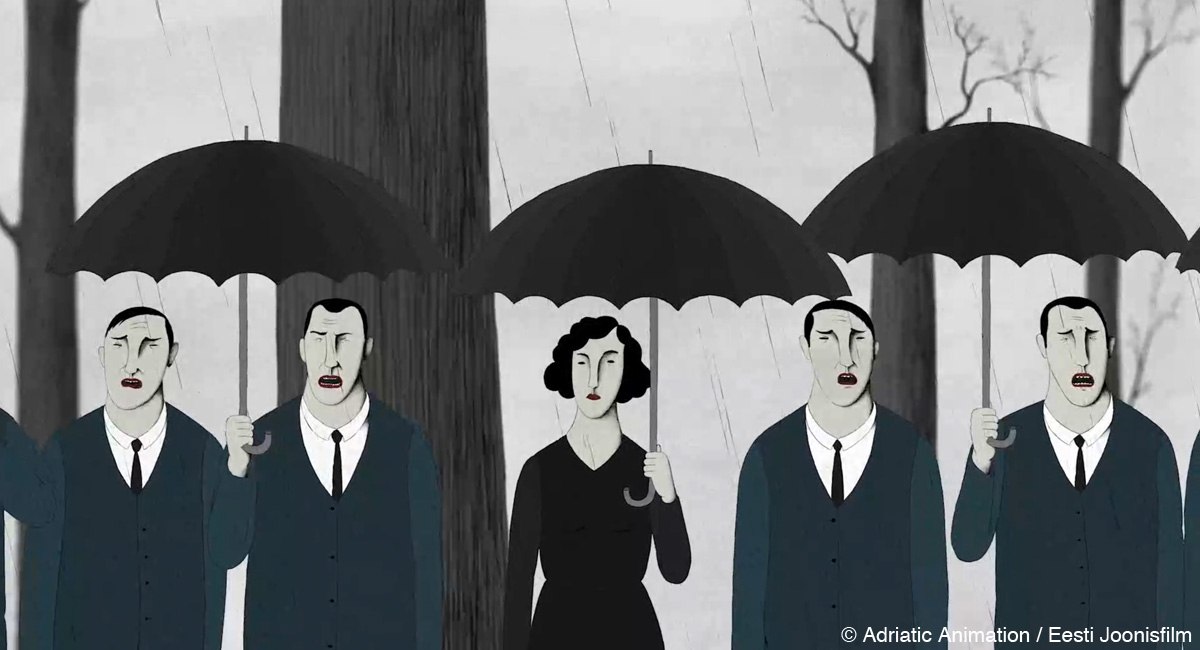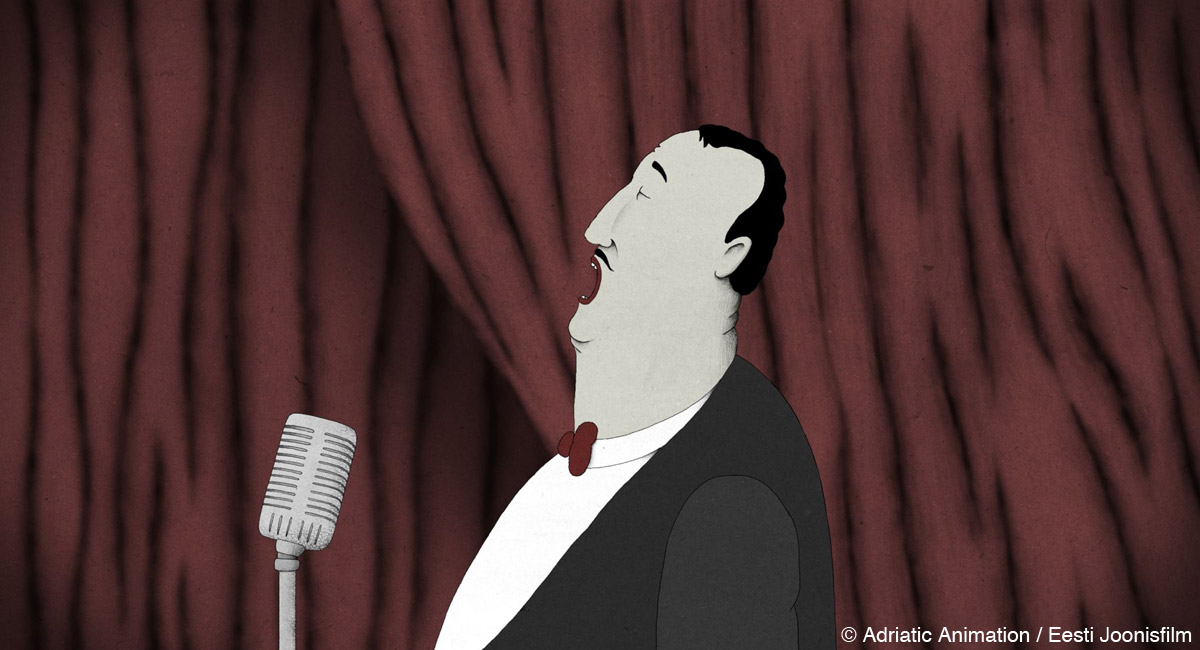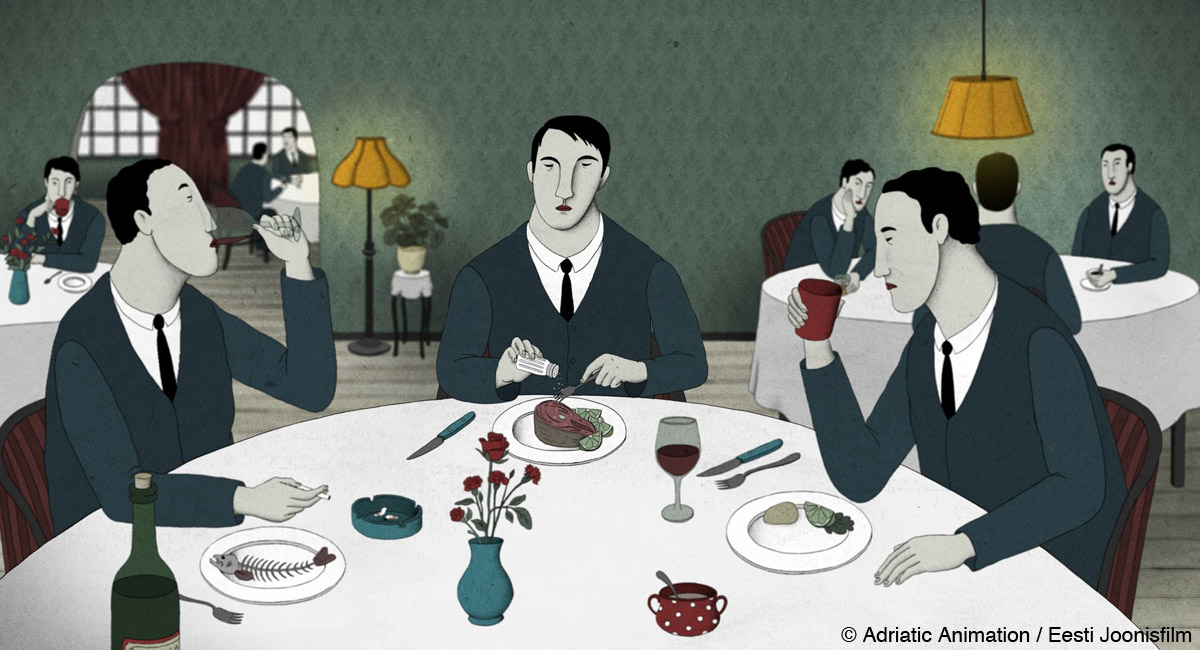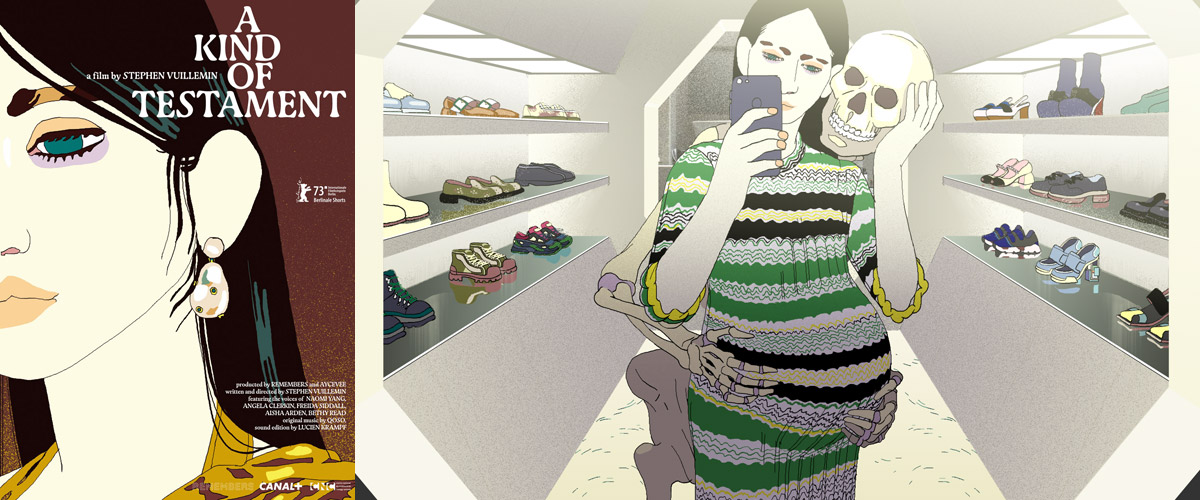Synopsis
It’s pouring down with rain at the funeral. There’s a lot of crying, too much wine, several woodpeckers and a couple of dreams that fill in the gaps.
Film Credit
Directors: Lucija Mrzljak and Morten Tšinakov
Production: Eesti Joonisfilm (Estonia) and Adriatic Animation (Croatia)
Screenplay: Morten Tšinakov
Music: Morten Tšinakov
Animation: Egert Kesa, Goran Stojnić, Morten Tšinakov, Lucija Mrzljak, Tarmo Vaarmets, and Noemi Ribić
Running Time: 15′ 58”
Eeva is an animated short film set in the day at the funeral of a widow’s husband. It has surrealistic character designs, hidden metaphors, sarcasm, and a refined balance between movement and stillness. All those elements perfectly support the film’s narrative that makes it visually unforgettable, finishing with a convincing ending.
The film won the Croatian Film Competition at Animafest Zagreb 2023, and the Alexeïeff – Parker Award at the Annecy International Animation Film Festival 2023. Eeva was also selected for Berlinale Shorts at the Berlin International Film Festival 2023.
We interviewed the directors of the film, Lucija Mrzljak and Morten Tšinakov, about the story behind the creation of this interesting film.
Interview with Lucija Mrzljak and Morten Tšinakov
Hideki Nagaishi (HN): What did you most want to portray or deliver to the audience through the film?
Lucija Mrzljak: I think Eeva is the most serious film we have done so far. We dealt with complex themes such as dark emotions, dreams and subconsiousness, we tried to approach all of that in an original way.
Morten Tšinakov: When watching films, I hope for some unexpected connections or some surprising ways to think about things discovered by the filmmaker that I myself would never think of. Ideally, that would be something that ‘Eeva’ offers as well.
HN: Please tell us about the division of roles between the two of you in producing this work.
Morten Tšinakov: I started to write the script when we were still working on our previous film The Stork and over time wrote (I think) 5 versions. When it felt that the script is ready, Lucija developed the character designs.
For the storyboard we sat down together, opened the script and brainstormed how a particular scene could look like. We chose the idea that suited the both of us and sketched it on a very small scale.
Later, Lucija would use those sketches to draw the layouts. She also designed most of the backgrounds. I figured out the colors, textures, blurs and shadows.
Animation and clean-up was divided between Eesti Joonisfilm, Adriatic Animation studios and ourselves.
Lucija Mrzljak: In such collaborative filmmaking process it’s nice that every segment of the film requires dialogue, dicussion and teamwork. I’m really happy we could work together in this way, with a lot of care and dedication for every detail of the film. By combining our efforts, we could create something that surpasses what either of us could have accomplished alone.
HN: Where did the initial idea of the film’s story come from?
Morten Tšinakov: It all started with a dream I had. In this dream, a woodpecker landed on a coffin, delivered a message in morse code and was killed by a woman standing next to the coffin. We have this exact scene in our film, only the background was changed. The rest of the story was developed around it.
HN: How did you develop the film’s entire story from the initial idea, and what did you take care the most while creating the story?
Morten Tšinakov: The process is always the same for me. I come up with some short scenes that seem funny or interesting and by trying to connect those scenes, I have to come up with some other ideas. It usually takes quite a long time to reach the final story and I’m constantly discarding the ideas I have come up with because they often aren’t as good as they seem at first. I would say that this is one of the best things that I learned during my animation studies – to admit to yourself that most of your ideas are not good enough and you shouldn’t feel bad discarding them.
Lucija Mrzljak: I guess this is something we have in common since we both studied animation as students of Priit Pärn. We learned to work with ideas in such way, searching for connections and interesting patterns until the elements fit together.
HN: I would like to ask you a few questions about the film’s visuals. The visual direction of the film is very impressive for me. The characters’ unique design is quite surreal: small black eyes without a sclera on a long face, exquisitely-drawn outlines, flat colouring with subtle shading, and a muted colour scheme. On the other hand, some the characters’ behaviour and facial expressions are slightly exaggerated. I also felt that the film visuals match the sense of humour that you scattered throughout the film. I found myself addicted to the film’s visual style after I finished watching.
How did you achieve the great integration between the aspects of the characters’ visual style and the film’s storytelling?
Lucija Mrzljak: You know, it’s difficult to explain because the designs of the characters, backgrounds and the colour palette came somehow naturally. Thinking about the story, I tried to imagine what kind of characters and visual atmosphere would fit into this frame. Besides animation I’m also a dedicated illustration artist and I love to create intricate detailed images with strong, surreal and oneiric atmosphere. Usually I would make many rough sketches and then we would discus with Morten every detail, every shade and every color. After that I would take a lot of time to draw everything in detail. So I guess somehow the visual designs organically grew into the final frame of the story.
HN: Morten, what part of Lucija’s illustrations is the most attractive for you, and what part of her illustrations especially matches up with the storytelling?
Morten Tšinakov: Lucija is an incredible illustrator. I like her attention to detail and the surreal elements in her drawings. She has her own, very recognizable style. I also admire the fact that she never cuts corners when making an illustration – if she has decided to make an illustration it’s certain that the result will be great.
The characters in her illustrations seemed to suit ‘Eeva’ especially well and we decided quite early on that we should aim for something similar. Lucija doesn’t really use computers when making illustrations and each picture takes a lot of effort to complete. When making an animated film, you have to draw hundreds of images so, unfortunately, we had to make some compromises and weren’t able to use those illustrations exactly. But in the end we are both happy with the result.
HN: I felt that having male-only characters surrounding the widow, and her bold or shocking behaviours at a restaurant that embody her emotions directly, are very important story elements that connects us to the film, because the obvious abnormality grabbed my attention and allowed me to clearly see that she is not in an environment that can handle a major emotional loss. I felt this realization allowed us to naturally follow the rest of the story to the end. I would like to hear the story behind the creation of these story elements.
Morten Tšinakov: I am very happy that you drew those connections while watching the film. For me it’s very interesting to hear.
Hopefully the reality behind creating those elements is not too disappointing – I just find groups of people looking and dressing exactly the same quite surreal, ridiculous and slightly funny.
Lucija Mrzljak: Also one of the explanations is that in the film we follow Eeva’s emotional point of view as she is truly wrecked by feelings of grief and guilt. So in that perspective all the people around her (family and friends) are somehow distant and their faces look the same to her. And I think the important point of the film is that Eeva is completely alone and missunderstood in her emotional journey.
HN: Could you please let us know your work for the music of the film?
Morten Tšinakov: Even though I’m not much of a musician I sometimes like to record music and I had quite a clear idea what the music should be like in this film. So the idea was that I would record something, try it out and if it suits the film we would use it, if not then we would search for an actual composer. When trying the music out we both thought that it fits and decided to go with it.
We also got lucky by finding a piece of music that is free to use. We reversed it and used that in a couple of places in the film.
Lucija Mrzljak: I really enjoyed the sound and voice creation for the film. It was important from the very beginning of the project. We discussed every melody and every sound, the audio was developed parallel with the visuals so it deeply affected the rhythm and atmosphere of every scene. It was impressive to see Morten’s dedication and uncompromising search for the right music and sounds which would accompany the scenes.
I’m glad I could give my voice as the actor for the female character, also I was singing in several parts of the film, including the big man with moustache who performs in the wake party.












